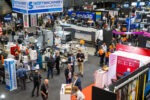The Canterbury engineering business with trained staff who never want to leave
Training at the heart of exporter’s success story An unwavering commitment to upskilling its people has helped keep tool maker Sutton Tools (NZ) out in front despite a string of setbacks including an earthquake, a pandemic, and in 2022, a fire that gutted their Kaiapoi factory. Now though, the future looks brighter than ever with a brand-new factory in Rangiora and a forward-focussed masterplan that will drive expansion and power up their knowledge base. Sutton Tools manufactures its high-quality cutting tools in Rangiora, as well as at two sites in Victoria, Australia before exporting them globally. Adopting a proactive approach to training has been a critical factor in their success, and a long-standing partnership with industry training organisation Competenz has been pivotal to this work. For over 30 years, Competenz has collaborated with Sutton Tools, offering apprenticeship and traineeship opportunities to enhance skills and engagement. Production Manager Brian McCallum has spent just shy of 25 years with the company and in that time, he has completed a string of Competenz programmes including a New Zealand Certificate in Workplace Health & Safety Practices (Level 3), a National Certificate in Competitive Manufacturing (Level 4), and a National Certificate in Manufacturing (Metal and Related Products) (Level 3). Currently he’s working towards his NZ Apprenticeship in Mechanical Engineering (Trade) (Level 4) – Fitting and Machining. “I went to Sutton for work experience when I was 17 and I never left,” says Brian. “In that time, I’ve been given lots of opportunities and done lots of different things within the company, including gaining qualifications and temporarily relocating to Australia after the fire to help with running one of the manufacturing plants in Melbourne.” With a myriad of development and career prospects – and a highly supportive, encouraging employer – he can’t see a reason to […]









